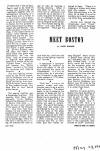
Home Page Meet Boston Menu Index
|
MEET BOSTON Friday, May 29, 1942 in What's New In Town W. J. Sidis |
It seems that in the old days, paint used to be made by mixing and pulverizing the ingredients together with an arrangement consisting of a stone block with a hollow in it for a mortar, and a globular stone for a pestle. Such a pair of stones was brought to Boston for that purpose in early colonial days by a paint-maker who settled there. The outfit was kept in front of his shop, in the rabbit-warren of narrow lanes between the North End and the old Town Dock (Dock Square). Surveyors got into the habit of starting surveys from this paint-mill as a base―encouraged by the paint-maker, who found it good advertising. On this account, when the place was rebuilt, the stone block and globe were permanently set into the walls. And, as surveys over in England were generally based on a marker called the “London Stone,” this paint-mill became the “Boston Stone,” similarly a first basis for surveying and mapping America.
*
The first fighting encountered by the British expedition to Middlesex was not at Lexington, as commonly supposed, but earlier that morning at Arlington Centre, when, as they passed through, they were shot at from behind picket fences.
*
The sewing machine was a Cambridge invention. The inventor, Elias Howe, came originally from Sudbury, home of the Wayside Inn, and of Mary’s Little Lamb―in fact, he was a poor relation of the owner. Like most New Englanders, he was interesting in experimenting with his dream invention, but seemed to be running short of ideas. Moving to Cambridge, where his wife took in sewing for a living, he watched her work to get an idea for building a sewing machine. When it was done, he took his machine out on exhibition, but could stir up no interest in it. Later, long after he had given up all attempts to get any money out of his invention, he saw an English outfit exhibiting “The Yankee Sewing Machine,” and sued them for infringement. Howe got his start that was, and from that time on the sewing machine had “arrived.”
*
A restaurant in Lexington is claimed by tradition as where the rebels in the old days planned the revolt for independence. It is still an eating place, as it was then, and it rejoices in the appropriate address of 1775 Massachusetts Avenue.
*
“Gold Star” names for square, streets, and playgrounds, seem to be a strictly local institution. The object seems to be to preserve the memory of those who fell in the last was, but the City of Boston has so overdone it (in contrast to most of the suburbs) that very few of those names are used or remembered. The use of full names, rather than last names, has contributed to this, by making the name of the place hard to remember; but also names of squares were often assigned where there was but a street crossing, and some crossings had two, or even three gold star names assigned to them. (There is a crossing in Allston with three gold-star names.) If any more memorializing is to be done, let us hope it is not so overdone as to lead to forgetting rather than remembering.
*
Anyone ever noticed the conspicuous word “Finish” painted in yellow on the street pavement of Exeter Street near Blagden? Many visitors in Boston have noticed this, and wondered who or what gets finished there. It actually marks the finish line for the marathon races run annually on April 19, the anniversary of the American Revolution. The custom commemorates the time when the British redcoats ran―encouraged by bullets from unseen sources―all the way from Central Middlesex into Boston, over 20 miles by the roads of that time, and made it in under three hours.
*
Contrary to usual opinion, Boston has more extremes of temperature than New York, heat as well as cold. New York’s hottest was 99; Boston’s heat record (July 4, 1911) was 104.* Still, it is true that hot spells are shorter in Boston than almost anywhere else in this country (the 104 temperature was down to 60 in about two hours); while Boston’s hottest days would be rated as cool for summer days in the prairies, or even in the supposedly ideal climate of Southern California.
_______
* Boston's record still holds, even though New York's is now 102°. See weather.com.